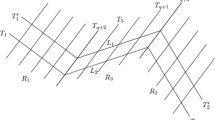Abstract
Given a finite group G, how many squares are possible in a set of mutually orthogonal Latin squares based on G? This is a question that has been answered for a few classes of groups only, and for no nonsoluble group. For a nonsoluble group G, we know that there exists a pair of orthogonal Latin squares based on G. We can improve on this lower bound when G is one of GL(2, q) or SL(2, q), q a power of 2, q ≠ 2, or is obtained from these groups using quotient group constructions. For nonsoluble groups, that is the extent of our knowledge. We will extend these results by deriving new lower bounds for the number of squares in a set of mutually orthogonal Latin squares based on the group GL(n, q), q a power of 2, q ≠ 2.
Similar content being viewed by others
References
Bateman P.T.: A remark on infinite groups. Am. Math. Monthly 57, 623–624 (1950)
Beth T., Jungnickel D., Lenz H.: Design theory, 2nd ed. Cambridge University Press, Cambridge (1999).
Colbourn C.J., Dinitz J.H. (eds.): Handbook of Combinatorial Designs, 2nd ed. Chapman and Hall/CRC, Boca Raton (2007).
Dalla Volta F., Gavioli N.: Complete mappings in some linear and projective groups. Arch. Math. (Basel) 61(2), 111–118 (1993)
Dénes J., Keedwell A.D.: Latin Squares and Their Applications. Akadémiai Kiadó, Budapest (1974).
Dénes J., Keedwell A.D.: Latin squares: new developments in the theory and applications. Annals of Discrete Mathematics, vol. 46. North Holland, New York (1991).
Evans A.B.: Mutually orthogonal Latin squares based on linear groups. In: Jungnickel, D. et al. (eds) Coding Theory, Design Theory, Group Theory (Burlington, VT, 1990), pp. 171–175. . Wiley-Interscience, New York (1993).
Evans A.B.: Orthomorphism graphs of groups. Lecture Notes in Mathematics, vol. 1535. Springer, Berlin (1992).
Evans A.B.: On orthogonal orthomorphisms of cyclic and non-abelian groups, vol. II, J. Combin. Des. 15(3), 195–209 (2007)
Evans A.B.: The admissibility of sporadic simple groups. J. Algebra 321, 105–116 (2009)
Ge G.: On (g, 4;1)–difference matrices. Discret. Math. 301, 164–174 (2005)
Hall M., Paige L.J.: Complete mappings of finite groups. Pacific J. Math. 5, 541–549 (1955)
Jungnickel D.: On difference matrices and regular Latin squares. Abh. Math. Sem. Univ. Hamburg 50, 219–231 (1980)
Jungnickel D.: Einige neue Differenzenmatrizen. Mitt. Math. Sem. Giessen 149, 47–57 (1981)
Michler G.: Theory of Finite Simple Groups. Cambridge University Press, Cambridge (2006)
Paige L.J.: Neofields. Duke Math. J. 16, 39–60 (1949)
Quinn K.A.S.: Difference matrices and orthomorphisms over non-abelian groups. Ars Combinatoria 52, 289–295 (1999)
Wilcox S.: Reduction of the Hall-Paige conjecture to sporadic simple groups. J. Algebra 321, 1407–1428 (2009)
Author information
Authors and Affiliations
Corresponding author
Additional information
Communicated by J. D. Key.
Rights and permissions
About this article
Cite this article
Evans, A.B. Mutually orthogonal Latin squares based on general linear groups. Des. Codes Cryptogr. 71, 479–492 (2014). https://doi.org/10.1007/s10623-012-9752-9
Received:
Revised:
Accepted:
Published:
Issue Date:
DOI: https://doi.org/10.1007/s10623-012-9752-9



